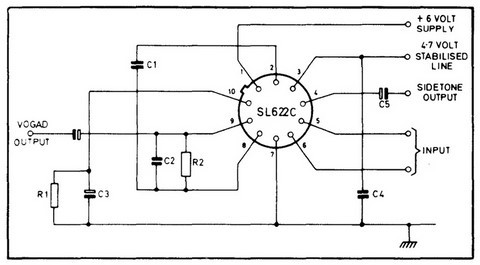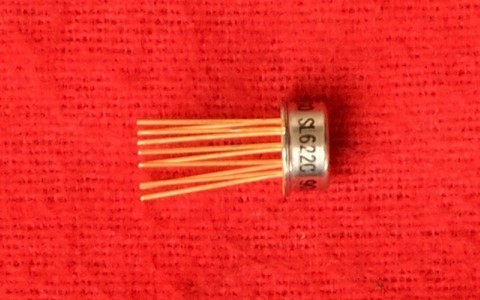SL622 VOGAD Amplifier
Features
- All Time Constants Set Externally
- VOGAD operating threshold: 100 µV
- Compatible with SL610/611/612
- Supply Voltage: 6V to 12V
- Supply Current: 14mA
- Operating Temperature: -55°C to +125°C
The SL622C is a silicon integrated circuit combining the functions of an audio amplifier with a voice-operated gain adjusting device (VOGAD).
It is designed to accept signals from a low sensitivity microphone and to provide a substantially constant output signal for a 60 dB range of input.
Additionally, a constant gain amplifier is incorporated, which provides an amplitude-limited output for sidetone in mobile transmitter/receiver applications.
The encapsulation is a 10 lead TO-5 package, and the device is designed to operate from a 6V to 12 volt supply, over a temperature range of -55°C to +125°C.
A voltage regulator produces an independent supply line at 4.7 Volts stabilised.
Circuit Description
The SL622C incorporates a series regulator which accept supply voltages between 6V and 12V and provides a supply line rejection of approximately 26 dB when operated from a 6V supply; the supply line immunity increases with supply voltage.
The input stage is a differential class A-B stage with an AGC terminal. The accurate balance of the input stage gives an overall common-mode rejection ratio of greater than 30 dB.
Typically the amplifier handles differential input signals of up to 375mV p-p and unbalanced signals of up to 50mV p-p. When used in the unbalanced mode either pin 5 or pin 6 may be used as the input, the other decoupled to earth.
Fig. 1 shows the SL622C when used as a balanced microphone amplifier. The IF cut-off of the amplifier is set by C1 and also by the values of coupling capacitors to the input pins (pin 5 and pin 6); coupling capacitors should be used if the D.C. potential of the input is not floating respect to earth.
The HF cut-off is set by C2. The VOGAD threshold may be increased by connecting an external conductance between pins 8 and 9. The threshold is increased by approximately 20 dB for 1 millimho of conductance; the value of C2 should be adjusted in conjunction with any threshold alteration to obtain the desired bandwidth.
C3 and R 1 set the attack and decay rates of the VOGAD. C3 = 47µF and R1 = 1 MOhm gives an attack time constant (gain increasing) of 20 ms and a decay rate of 20 dB/sec. C1 = 2.2µF and C2 = 4.7nF give a 3dB bandwidth of approximately 300Hz to 3kHz.
The amplifier can be muted by applying +4V to pin 10, but when the voltage is removed either C3 must be discharged, or there is an appreciable delay before the circuit functions normally again.
C4 is used for RF decoupling of the stabilised line. AF decoupling may be applied to improve supply line rejection and sidetone linearity.

Fig. 1
